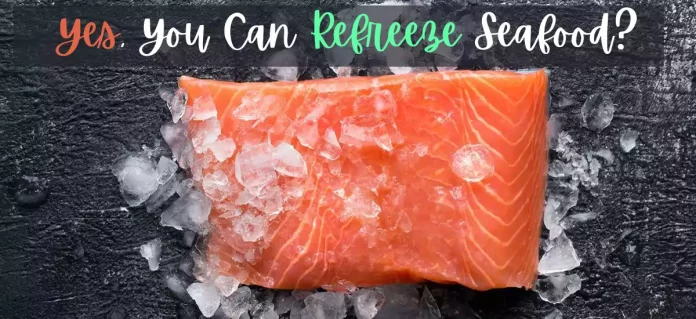Yes, You can refreeze but it varies according to your product- meat, poultry, and fish in the refrigerator, you may refreeze it without cooking. However, there may be some quality loss due to moisture loss while thawing. You may refreeze previously frozen meat, poultry, and fish after cooking them.
How To Thaw Frozen Seafood
Frozen food should never be thawed at room temperature since it poses a health risk. Foods can be thawed in the refrigerator for 1 to 2 days. Larger goods, such as entire turkeys, may take longer to prepare. 1 day per 5 pounds of weight is a good estimate. You can defrost in cold water as well.
Put the food in a leak-proof plastic bag first, then submerge it in cold water. Every 30 minutes, change the water. Cook right after after thawing.

You may also defrost frozen food in the microwave, but you should cook it right away. This is due to the microwave’s uneven heat distribution, which implies that some of the food may have begun to cook.
Can You Refreeze Seafood Twice?
As long as you do it right, you may thaw and refreeze fish as many times as you like. Frozen fish should be thawed gently in the refrigerator, never at room temperature. If the seafood has been sitting at room temperature for more than two hours or has been too thawed, it should be discarded.
Guide About: Is Breastfeed Safe If I Have Food Poisoning
Best Ways To Refreeze Seafood
- Place on ice right away– Submerge the fish in ice until ready to fillet.
- Sort into meal-size servings after processing– As fast as possible, clean your catch. Cut and sort the fillets according to how many you’ll be cooking at once.
- Rinse well with cold water– This will aid in the removal of any remaining slime, particle, or other impurities that may have harmed the flavor. Using a paper towel, pat dry.
- Place the items in plastic bags– Three to four fillets should be placed in each of the quart-size bags. Some say that water should be put to the bags for freezing fresh fish, however this might convert flesh to mush if not done carefully.
- Take out the air– Freezer burn can occur as a result of air exposure, damaging the meat. A vacuum sealer is a good preservation method, however plastic zip-top bags can also be used. Prepare a big bowl of water and dip the open bag’s bottom into it until the water reaches the top of the fish (but not overflowing into the bag).
- This functions as a vacuum sealer– sucking the air out of the container. Before freezing fish, make sure the top is tightly closed.
- The meat is wrapped in butcher paper– If the plastic bag in the freezer is ruptured, the contents will be protected from exposure to cold air and freezer burn.
Some Benefits Of Refreezing Seafood
- Freezing is a natural method of preservation that does not need the use of chemicals.
- When you freeze fish and seafood, you get excellent quality all year.
- Using frozen fish and shellfish lowers waste by allowing you to use as much or as little as you wish.
- Frozen fish and seafood are up to 25% less expensive than fresh.
- Thanks to advancements in freezing technology, you may eat all varieties of fish and seafood all year long, regardless of the season, and at reasonable pricing.
- Frozen seafood and fish make fish more accessible to everyone. It provides everyone with better nutritional advantages.
- The caterer may create a whole dinner and menu by using frozen fish and seafood.
Precautions When Refreezing Seafood
It’s important to remember that freezing and refreezing might have an impact on the quality of the fish.

When you freeze fish, the ice crystals that develop can harm the fish’s cell membranes. So stay away from that.
- Before you refreeze the fish, ensure sure it’s thoroughly thawed.
- Make sure the fish is properly wrapped to avoid freezer burn.
- Make certain the fish isn’t over its sell-by date.
The fish will not taste as delicious as previously, and the texture may alter significantly. Finally, it would be beneficial if you solely refroze already frozen seafood. Fresh seafood will not freeze correctly and may deteriorate if you try to freeze it.
Frequently Asked Questions
1. Why Shouldnt You Refreeze Seafood?
Because the fish fillets might have at least momentarily warmed up to a temperature greater than 40°F using either approach. At that point, hazardous germs can grow, and only more cooking will kill them; merely refreezing the fish fillets would not enough.
2. Can You Freeze Seafood Twice?
Yes, you may safely freeze and refreeze cooked or uncooked fish that has been thawed in the refrigerator.
3. Can You Refreeze Previously Frozen Seafood?
Yes, previously frozen fish can be refrozen. It is important to remember, however, that freezing, and refreezing might have an impact on the quality of the fish. When you freeze fish, the ice crystals that develop can harm the fish’s cell membranes.
Related Post: Can You Refreeze Hotdogs
